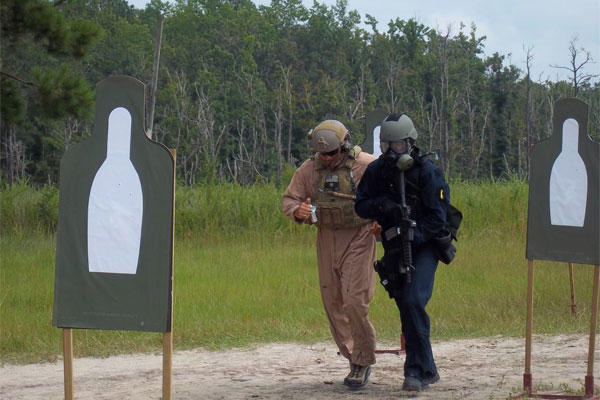The Coast Guard’s Special Missions Training Center, located in Courthouse Bay at the Marine Corps Base Camp Lejeune, has kicked off the new fiscal year with the start of its Basic Tactical Operators Course. The BTOC is one of the several tactical training courses offered at the SMTC, and has been an active course since 2008. Students arrive from Maritime Security Response Teams, Maritime Safety and Security Teams and Tactical Law Enforcement teams (TACLETs) from throughout the Coast Guard to attend the eight-week course that covers basic marksmanship, combat marksmanship and close-quarters combat.
During the welcome aboard time, students and instructors work together to ensure all necessary gear is assembled properly for tactical operations. Students are given a small overview of the step-by-step process they are expected to master during the flat range part of the course.
“We give the students time to get familiar with their equipment and get their kits squared away properly,” said Petty Officer 1st Class Eric Warren, a maritime enforcement specialist and the primary instructor for the flat range portion of the course.
In the first four weeks of BTOC, students are on flat ranges, learning how to move from basic marksmanship to tactical maneuvers. They learn different ways to safely use their weapons in situations such as coming up behind barriers, moving while shooting and traveling up and down ladders. All skills are applied to close-quarters combat.
“Close-quarters combat training trains students to know where you and your team are supposed to be in relationship to a threat,” said Chief Petty Officer Robert Wills, the BTOC course chief, .
During the last four weeks of the BTOC, students learn how to breach doors and go through a room as a coordinated boarding team, using non-verbal signals to guide them through a building while making split second tactical decision as they mentally discriminate between possible threats.
Instructors for the course are comprised of Coast Guard members, civilian employees and contractors. All three entities work together, combining their experience and knowledge to give the students the best tactical training possible.
“They are subject matter experts,” said Petty Officer 1st Class Gregory Aulds, a maritime enforcement specialist, speaking of his instructor cadre. As an instructor, Aulds works with his colleagues to ensure students understand and retain the specialized training the students receive during the course.
In order to give students the appropriate student to instructor ratio, the group is split into four, eight-man boarding teams. Students are assigned a number and are referred by that number during the course.
“The students are expected to follow task direction to acquire the skills they need,” said Aulds. As an instructor, Aulds has high expectations from the students the moment he meets them.
Students learn skills by watching instructor demonstrations and imitating with dry fire. When the range goes hot, the students put what they learn to practice by shooting hundreds of bullets into targets every day. At the end of each range day, students converse with their instructors in a classroom-type atmosphere. The boarding teams dissect what they learned that day and how it is applied in a regular non-training environment.
The BTOC runs with the assistance of the Support Operation Cell.
“We maximize training time by providing essential supplies and set up, so the instructors can focus on the students,” said Petty Officer 2nd Class Michael Porvaznik, a machinery technician and the lead petty officer for the SOC division.
The SOC members initiate range set up and take down as well as transportation of range consumables and targets. They handle weapons transport and are held accountable for ammunition distribution. SOC members work with instructors to evaluate the future needs of BTOC logistics by tracking inventory of all necessary supplies and outfitting the vehicles to most efficiently handle BTOC demands. They also build barricades as well as walls for customized CQC floor plans.
The SMTC medical staff also plays an important role in BTOC. Two health service technicians are on the range at all times, and firing cannot commence without their presence in case of mishap. They stand watch along the firing line making sure students do not lose training time due to an unexpected injury. The range corpsmen run frequent drills to ensure quality care and speed of transportation.
The course came to an end Dec. 14. Students were recognized with the BTOC Leadership Award and the Top Shooter Award. The students will return to their duty stations to apply what they have learned throughout the course to be more effective in tactical operations and missions.
























